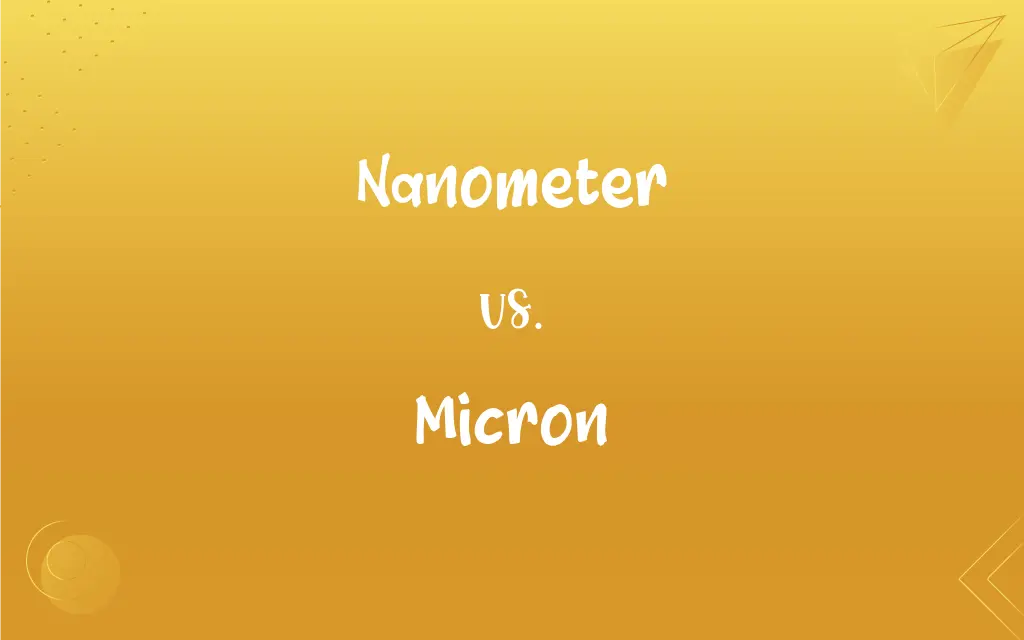Nanometer vs. Micron: What's the Difference?
Edited by Harlon Moss || By Janet White || Updated on October 20, 2023
A nanometer (nm) is a unit of length equal to one billionth of a meter; a micron (μm) is an informal term for a micrometer, or one millionth of a meter.

Key Differences
Nanometers and microns are both units of length in the International System of Units (SI), used to measure very small distances or dimensions. However, a nanometer, encompassing one billionth of a meter, is significantly smaller than a micron, which is equivalently one millionth of a meter. These units are critical in fields such as physics, chemistry, biology, and engineering, particularly when dealing with microscopic and nanoscopic phenomena.
The scale of a nanometer is so minute that it is predominantly used in scientific endeavors to measure things like the wavelengths of electromagnetic radiation, dimensions of molecules, or the size of microscopic particles. The nanotechnology industry, for instance, relies on the nanometer as its standard unit of measurement, given that it deals with manipulations on the molecular and atomic levels. In contrast, a micron, being larger, is a common measurement in microscopy, often used to detail the sizes of cells or microorganisms.
It's essential to comprehend the sheer minuteness of both the nanometer and micron. A single nanometer is so small that comparing it to a meter is like comparing the size of a marble to the size of the Earth. The micron, while larger than the nanometer, is still incredibly small; one micron is about the same length as a row of about 10 human cells.
In practical applications, the distinction between nanometer and micron measurements can be pivotal. In the semiconductor industry, for example, the nanometer is the standard for measuring the sizes of components etched onto the surfaces of computer chips. These components are often only a few nanometers across. The micron, on the other hand, might be used in mechanical engineering or material sciences to measure things like the thickness of a piece of paper or the diameter of a human hair, which are in the range of tens to hundreds of microns.
Additionally, the conversion between nanometers and microns is crucial for scientists and engineers. Understanding that one micron is equal to 1,000 nanometers is fundamental in scientific research and technology development. This knowledge ensures accuracy and consistency in measurements and calculations, whether one is measuring the wavelength of light in nanometers or the size of bacteria in microns.
ADVERTISEMENT
Comparison Chart
Size
One billionth of a meter
One millionth of a meter
Common Uses
Nanotechnology, measuring atomic structures
Microscopy, measuring cell sizes
Industry
Semiconductor manufacturing
Material sciences, mechanical engineering
Relative Scale
Comparable to atoms and molecules
Comparable to cells and microorganisms
Conversion
1 micron = 1,000 nanometers
1 micron = 1 micrometer
ADVERTISEMENT
Nanometer and Micron Definitions
Nanometer
A nanometer is a standard used in nanotechnology for atomic-scale measurements.
Researchers have developed a transistor that's only ten nanometers in size.
Micron
A micron is a metric unit of length equal to one millionth of a meter.
A human red blood cell is about 5 microns in diameter.
Nanometer
A nanometer is a metric unit for measuring the thickness or diameter of microscopic particles.
The nanoparticle had a diameter of 50 nanometers.
Micron
A micron is an informal term for a micrometer.
The engineer measured the sheet's thickness to be 10 microns.
Nanometer
A nanometer is a unit of spatial measurement used in microscopy.
The bacterial cell wall measured about 40 nanometers thick.
Micron
A micron is a common measurement in microscopy, often used for cell sizes.
Under the microscope, we observed particles of 2 microns in size.
Nanometer
A nanometer is a unit of measure equating to one billionth of a meter.
The size of a water molecule is less than one nanometer.
Micron
A micron is a unit used to measure microscopic entities.
The pollen grains ranged from 20 to 80 microns across.
Nanometer
A nanometer is used to measure wavelengths of light in the visible spectrum.
The wavelength of red light is approximately 700 nanometers.
Micron
A unit of length equal to one thousandth (10-3) of a millimeter or one millionth (10-6) of a meter. Also called micrometer.
Nanometer
One billionth (10-9) of a meter.
Micron
(physics) The thousandth part of one millimeter; the millionth part of a meter.
Nanometer
Alternative spelling of nanometre
Micron
(figurative) A very tiny amount.
Nanometer
A metric unit of length equal to one billionth of a meter
Micron
(linguistics) breve
Micron
A measure of length; the thousandth part of one millimeter; the millionth part of a meter.
Micron
A metric unit of length equal to one millionth of a meter
Micron
A micron is a standard measurement in various scientific and engineering fields.
The new filter traps contaminants larger than 0.5 microns.
FAQs
Is "Micron" an official SI unit?
No, it's an informal term for a micrometer.
How small is a "Nanometer" compared to a meter?
A nanometer is one billionth of a meter.
Why is a "Nanometer" important in technology?
It's vital for nanotech and semiconductors, dealing with atomic and molecular scales.
Can standard microscopes measure in "Microns"?
Yes, they're used for objects in the micron scale.
Why is the "Nanometer" scale important in computing?
It's used for the smallest components in computer chips.
What typically is measured in "Microns"?
Things like cell sizes, bacteria, and fine particles.
Does "Nanometer" have a symbol?
Yes, it's "nm."
Is a "Nanometer" visible to the human eye?
No, it's far too small.
Can "Nanometer" and "Micron" be used interchangeably?
No, they represent different scales; a micron is 1,000 times larger than a nanometer.
Are human hairs measurable in "Microns"?
Yes, they're about 40 to 300 microns wide.
What's the symbol for a "Micron"?
It's "μm" for micrometer, often used interchangeably.
Are pollutants measured in "Microns"?
Yes, particularly in air and water quality contexts.
How many "Nanometers" are in a "Micron"?
1,000 nanometers.
What's the significance of "Micron" in air filters?
They often capture particles down to certain micron sizes for air purity.
What fields commonly use the "Nanometer" scale?
Fields like nanotechnology, semiconductor fabrication, and quantum physics.
Do "Microns" have a role in healthcare?
Yes, they're used in imaging and measuring cells and microorganisms.
What industries rely heavily on "Nanometer" measurements?
Nanotechnology, pharmaceuticals, and semiconductor manufacturing.
How is light wavelength related to "Nanometers"?
Visible light wavelengths range from about 380 to 750 nanometers.
How accurate are "Micron" measurements?
They're very accurate with proper equipment, crucial for scientific research.
Are there things smaller than a "Nanometer"?
Yes, such as atoms and subatomic particles.
About Author
Written by
Janet WhiteJanet White has been an esteemed writer and blogger for Difference Wiki. Holding a Master's degree in Science and Medical Journalism from the prestigious Boston University, she has consistently demonstrated her expertise and passion for her field. When she's not immersed in her work, Janet relishes her time exercising, delving into a good book, and cherishing moments with friends and family.
Edited by
Harlon MossHarlon is a seasoned quality moderator and accomplished content writer for Difference Wiki. An alumnus of the prestigious University of California, he earned his degree in Computer Science. Leveraging his academic background, Harlon brings a meticulous and informed perspective to his work, ensuring content accuracy and excellence.
































































